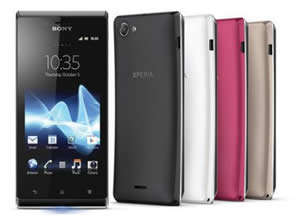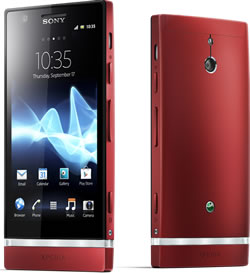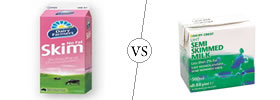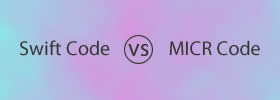Difference between Sony Xperia J and Sony Xperia P
Key difference: Xperia J was announced in October 2012 as a cheaper variant of the Xperia T, resulting in the phone sporting a similar design to the T. The Xperia J features a 4-inch scratch-resistant TFT touchscreen that offers a pixel density of 245. Sony Xperia P features a 4-inch TFT touch screen that allows up to 4-touch capabilities. The screen is scratch resistant and has a shatter proof coating. The touch screen provides approximately 275 ppi pixel density along with WhiteMagic technology, which adds an extra white pixel with the already present red, blue and green.

Xperia is a well known brand of smartphones that are a part of the Sony Mobile. The Xperia brand was initially a collaboration with Ericsson but has since then been dissolved. Now, Sony has single handedly taken it upon itself to ship out new phones, while maintaining the level of quality and design of the older versions. In order to garner response for its new line of smartphones, the company started marketing the Sony Xperia T as the Bond phone, which is featured in the movie Skyfall. Xperia J is the shy, younger brother of the Bond phone, and is also cheap to boot.
The Xperia J was announced in October 2012 as a cheaper variant of the Xperia T, resulting in the phone sporting a similar design to the T. The Xperia J features a 4-inch scratch-resistant TFT touchscreen that offers a pixel density of 245. The pixel density is the not the best among the contenders, but that does not hinder the high-res display that is visible on the phone. The display shows quite smart and sharp images, with very accurate color representation. The display also has excellent viewing angles and does is less reflective under sunlight.
The design of the phone is also quite similar to Xperia T. The phone comes with a plastic chassis that has a sturdy built. The Xperia J has an arched back similar to Xperia Arc series, which is pleasing to hold and grip. The silver plastic lining that graces the other Xperia series has been shifted to the bottom and acts as a second LED indicator during calls. The phone is also quite light, weighing only 124 grams. The Timescape UI is very similar to the original Google Android UI and basically seems like cheap imitations. The phone has three capacitive buttons on the bottom of the screen, Back, Home and Menu buttons. The buttons are placed on the far bottom of the device, making it more prone for the user to drop the device. The top of the device houses the 3.5mm jack, while the left side has the USB/charging port. The right side of the device is quite busy with the power/lock key on the top right hand and the volume rocker just below the power key.
The device is powered by 1 GHz Qualcomm processor and only 512 MB, which makes the device a little glitch and lagging when trying to shift screens as well as switch apps. The device, when not multitasking and doing basic functions, still lags a little. The device comes with 4 GB of internal space, of which only 2 GB is available to the user. This is very little compared to phones that are offering 8/16/32 and even 64 GB. However, the company has provided a SD card slot that allows users to expand memory by another 32 GB.
The device houses a 5 MP rear camera with autofocus feature. Just above it, a LED flash light can also be found. However, the front camera and the video recording capabilities are a little disappointing. Both, the front camera and video recording are VGA, which does provide the best resolution. The 5 MP camera is pretty decent, but if you have gotten used to the high-res 8 and 12 MP cameras, this camera will not at all be pleasing. The camera takes decent photos, but it isn’t sharp, clear or even HD for that matter. However, the phone does come with juice, 1750 mAh to be exact. This ensures that the phone last a couple of days when not in constant use and at least a full day when working with it all day. The company does offer features such as Wi-Fi hotspot, Bluetooth and USB, but it does not offer NFC capabilities.
 The constant dynamic nature of technology ensures that we always have a better and more forward technology than the one we had a month ago. The price of this dynamic technology is also high, the constant updating of technology requires people have that much cash on hand. However, many companies such as Sony know that not many people have that much cash on hand for disposal, hence has launched mid-range phones such as Xperia P that allows the people to experience the best of both worlds: technology and affordable pricing. The Xperia P was launched in May 2012 and continues to be a major player in the market.
The constant dynamic nature of technology ensures that we always have a better and more forward technology than the one we had a month ago. The price of this dynamic technology is also high, the constant updating of technology requires people have that much cash on hand. However, many companies such as Sony know that not many people have that much cash on hand for disposal, hence has launched mid-range phones such as Xperia P that allows the people to experience the best of both worlds: technology and affordable pricing. The Xperia P was launched in May 2012 and continues to be a major player in the market.
Sony Xperia P features a 4-inch TFT touch screen that allows up to 4-touch capabilities. The screen is scratch resistant and has a shatter proof coating, allowing the screen to endure minor scratches and everyday scuffs without sacrificing on the quality. The touch screen provides approximately 275 ppi pixel density, though not the best ppi compared to the heavy contenders but the quality of the screen is not sacrificed. This is mostly because of the company’s WhiteMagic technology, which adds an extra white pixel with the already present red, blue and green. The extra pixel generates a higher level of brightness that does not cloud the phone when using it under direct sunlight.
The phone is a little bulky in nature, but it is easy to become accustomed to when holding it for longer periods of time. The phone is also a little heavier compared to similar phones, but again not something that lets the user forget of the other great features of the phone. The phone is encased in a plastic chassis, which is quite smooth to hold but is also prone to many visible scratches and chips. The device has a clear plastic border on the front that also doubles as a cover for the antenna. Above the plastic border reside the Home button, back button and Menu button. The power button, the volume rocker and the physical camera button is on the right side of the device, while the left sides hosts a variety of ports including the SIM card slot.
Under the hood, the device is powered by 1 GHz Dual-core processor and hosts the company’s Timescape UI. The user interface is quite smooth and does not glitch when shifting between the screens and the apps. The device runs on 1 GB RAM and comes with an internal storage capacity of 16 GB. Of the 16 GB, only 13 GB is available to the user and it is not expandable. The device houses an 8 MP Autofocus rear camera and a VGA (0.3 MP) front camera, which is a little bit of a letdown. The Exmor R technology ensures that the rear camera provides sharp, clear images, while the front camera does not live up to the same quality. Though initially powered by Android v2.3, the device is now available with Android v4.0, which no status as of yet for v4.1 upgrades. The phone also comes with additional features such as Motion gaming, MobiSystems’ OfficeSuite 5, Wi-Fi hotspot, DLNA, USB On-the-go, Native USB tethering and NFC capabilities. The Xperia P houses a non-removable 1305 mAh battery, which provides a decent battery life and lasts almost a day. With the amount of features that are offered with the phone, the price tag is expected to be quite high; however, the price is quite affordable and will not make that much of a dent in the user’s pocket.
The information for the detailed table about the two phones has been taken from Sony Mobile website, expertreviews.co.uk and GSMArena.com
|
|
Sony Xperia J |
Sony Xperia P |
|
Launch Date |
October 2012 |
May 2012 |
|
Company |
Sony |
Sony |
|
Size |
124.3 x 61.2 x 9.2 mm |
122 x 59.5 x 10.5 mm |
|
Display |
4-inch scratch-resistant TFT touchscreen |
4-inch scratch-resistant TFT touchscreen |
|
Screen |
480 x 854 pixels (~245 ppi pixel density), 16 million colors |
960 x 540 pixels (~275 ppi pixel density), 16 million colors |
|
Protection |
Corning Gorilla Glass |
Scratch-resistant, shatter proof sheet on mineral glass |
|
Weight |
124 grams |
120 grams |
|
2G Network |
GSM 850 / 900 / 1800 / 1900 |
GSM GPRS/EDGE 850, 900, 1800, 1900 |
|
3G Network |
HSDPA 900 / 2100 - ST26i HSDPA 850 / 1900 / 2100 - ST26a |
UMTS HSPA 850, 900, 1900, 2100 |
|
4G Network |
N/A |
N/A |
|
GUI |
Timescape UI |
Timescape UI |
|
CPU speed |
1 GHz Qualcomm processor |
1 GHz Dual core processor |
|
GPU |
Adreno 200 |
Adreno 205 |
|
OS |
Google Android 4.0 (Ice Cream Sandwich) |
Android OS, v2.3 (Gingerbread), v4.0 (Ice Cream Sandwich), planned upgrade to v4.1 (Jelly Bean) |
|
Chipset |
Qualcomm MSM7227A Snapdragon |
NovaThor U8500 |
|
RAM |
512 MB |
1GB |
|
SIM Size |
miniSIM |
microSIM |
|
Internal Memory |
4 GB (2 GB available to user) |
16 GB (13 GB accessible to the user) |
|
Expandable Memory |
Up to 32 GB |
N/A |
|
Sensors |
Accelerometer, Proximity sensor, Magnetometer |
Accelerometer, Proximity sensor, Ambient light sensor, Magnetometer and Gyroscope |
|
Connectivity |
GSM GPRS Up to 86 kbps (download). Up to 86 kbps (upload); GSM EDGE Up to 237 kbps (download). Up to 237 kbps (upload); microUSB v2.0; DLNA; Wi-Fi hotspot; Wi-Fi; Bluetooth |
USB High speed 2.0 and Micro USB support, WiFi and WiFi Hotspot functionality, HDMI Support, DLNA Certified, Synchronisation via Exchange ActiveSync, Google Sync and Facebook, aGPS, WebKit web browser with Pan & zoom, Bluetooth technology, Native USB tethering and NFC. |
|
Data |
GPRS, EDGE, WLAN, Wi-Fi hotspot, Bluetooth and USB. |
GPRS, EDGE, WLAN, Bluetooth, NFC, USB. |
|
Speed |
HSDPA, 7.2 Mbps; HSUPA, 5.76 Mbps |
GSM GPRS Up to 100 kbps; GSM EDGE Up to 296 kbps; UMTS HSPA cat 6 (upload) Up to 5.6 Mbps; UMTS HSPA cat 10(download) Up to 14.4 Mbps |
|
WLAN |
Wi-Fi 802.11 b/g/n, DLNA, Wi-Fi hotspot |
Wi-Fi 802.11 b/g/n, Wi-Fi hotspot, DLNA |
|
Bluetooth |
Bluetooth v2.1 with A2DP, EDR |
Bluetooth v2.1 with A2DP, EDR |
|
USB |
microUSB v2.0 |
microUSB v2.0, USB On-the-go |
|
Primary Camera |
5 MP 2592х1944 pixels rear camera |
8 MP 3264x2448 pixels rear camera |
|
Secondary Camera |
VGA (0.3 MP) front camera |
VGA front camera |
|
Video |
VGA |
HD video recording (1080p) |
|
Camera Features |
|
|
|
Sound Enhancement |
xLOUD Experience Clear Stereo |
xLOUD Experience Clear bass and clear stereo |
|
Audio supported formats |
MP3/ eAAC+/ WMA/ WAV player |
MP3, 3GPP, MP4, SMF, WAV, OTA, Ogg vorbis |
|
Video supported formats |
MP4/ H.263/ H.264/ WMV player |
3GPP, MP4 |
|
Battery Capacity |
Removable Li-Ion 1750 mAh battery |
Non-removable Li-Ion 1305 mAh battery |
|
Talk time |
2G: 5 hours 36 min 3G: 607 hours |
2G: 6 hours 3G: 5 hours |
|
Stand-by |
2G: 7 hours 18 min 3G: 618 hours |
2G: 470 hours 3G: 475 hours |
|
Available Colors |
Black, White, Pink, Gold |
Black, Silver, Red |
|
Messaging |
SMS (threaded view), MMS, Email, IM, Push Email |
SMS (threaded view), MMS, Email, IM, Push Email |
|
Browser |
HTML5, Adobe Flash |
HTML5, Adobe Flash |
|
Radio |
Stereo FM radio with RDS |
FM Radio with RDS |
|
GPS |
GPS with A-GPS support |
GPS with A-GPS support |
|
Java |
Java via Java MIDP emulator |
Java via Java MIDP emulator |
|
Additional Features |
|
|
Images Courtesy: sonymobile.com









Add new comment